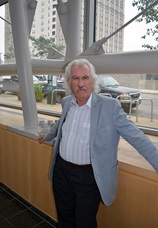Welcome From The Director

Alexander Fridman
John A. Nyheim Chair Professor
Director, Nyheim Plasma Institute
Mission
The C. & J. Nyheim Plasma Institute was established in 2002 as a multidisciplinary research and educational institute at Drexel University in Philadelphia, PA. NPI involves 25 faculty members and 35 students (including 12 PhD candidates) from the College of Engineering, College of Medicine, School of Biomedical Engineering and Health Systems, and College of Arts and Sciences. Faculty and students of the Institute publish 40-50 papers annually in some of the most prestigious journals in their fields. Their cutting-edge research results in 10-15 inventions each year filling crucial gaps in modern technologies.
What Is Plasma, And What Are Its Uses?
Plasma is the fourth and most energetic state of matter, where atoms and molecules are transformed, at least partially, into freely moving charged particles – electrons and ions. It presents some unique challenges for experimental researchers. Plasma's occur naturally and comprise the majority of perceptible matter in the universe including solar corona, solar wind, nebula, the earth’s ionosphere, aurora borealis and lightning. Plasma is also the most magical state of matter. The phenomena of chemical physics and biophysics, which emerge from the application of plasma's in various media and substrates, can be unexpected and extraordinary. The temperature of charged particles in plasma can be so high, that their collisions can result in thermonuclear reactions!
Generation and stabilization of plasma's in the laboratory and in industrial devices are not easy but hold great promise for a wide array of modern applications, including thermonuclear synthesis, electronics, lasers, medicine and many others. Plasma is already accepted as mainstream in a number of industries as illustrated by consumer products such as energy-efficient lamps and increasingly large television screens. Most personal computing hardware is manufactured using processes involving plasma technologies. Drexel is especially proud to be recognized as the birthplace of a novel and extremely promising branch of biomedical engineering - Plasma Medicine. It was conceived through effective collaboration of scientist engineers and medical doctors at NPI in 2003 and is now rapidly expanding at academic institutes throughout the world. Plasma Medicine is an important new field of research that has already helped improve the quality of life of several thousand patients all over the globe. Bravo Drexel!
The C. & J. Nyheim Plasma Institute consists today of 6 laboratories, signifying 6 major directions of NPI research:
- Plasma Energy Laboratory, led by Prof. Rabinovich, is focused on fuel conversion, fuel desulfurization and cleaning, CO2 sequestration, treatment of biomass, hydrogen production, waste-to-energy conversion, and recently on treatment and liquefaction of shale gas.
- Plasma Water Treatment and Environmental Control Laboratory, led by Prof. Young Cho, is focused on water softening, desalination and disinfection, exhaust gas cleaning, and since 2011 on cleaning and disinfection of energy-field wastewater produced from exploration for shale oil and gas.
- Plasma Medicine Laboratory, led by Prof. D. Dobrynin (bio engineering), and Prof. G. Friedman (engineering medicine). is focused on studying the role of plasma in prevention and treatment of many different diseases. Active projects examine the use of plasma sources for sterilization of different surfaces, including living tissues, disinfection of food, water and air streams; wound healing, tissue repair and regeneration, stimulation of angiogenesis, stimulation of cells of the immune system, treatment of cancers etc. Additionally, the laboratory is also focused on plasma's in agricultural practices.
- Applied Plasma Physics Laboratory, led by Prof. D. Dobrynin, is focused on development and characterization of novel plasma sources, including nanosecond pulsed plasma and plasma in liquids; development of plasma spectroscopy and other plasma methods of plasma diagnostics; as well as physics and chemistry of plasma catalysis and plasma assisted combustion.
- Computational Physics Laboratory, led by Prof. D. Vainchtein,is focused on numerical and analytical methods, space and laboratory plasma, aerodynamics, and fluid mechanics.
- Plasma Electrodynamics Laboratory, lead by Prof. A. Maltsev, is focused on investigations of physical phenomena related to hard electrons generation in dense gas discharge, on research of different forms of atmospheric discharges with runaway electrons and their action on gases, liquids, solid surfaces, and biological objects, as well as on study of synergetic action of atmospheric plasma and nano-particles (generated in air bubbles inside water) on water pollutants, and on development of effective technologies for deep removing of toxic ions and complex organic and biological pollutants from water.
NPI Mission in research, education and service as formulated in the NPI 5-years Strategic Plan:
- Maintain an internationally recognized research program in plasma science and engineering, helping to ensure the U.S. remains a world-leader in this field;
- Contribute to the development of a globally-competitive workforce prepared to innovate in this extremely fast-growing area; and
- Translate NPI research outcomes into products and services that benefit society.
Alexander Fridman
Director of C. & J. Nyheim Plasma Institute
Nyheim Chair Professor